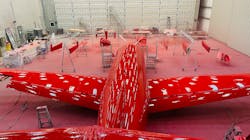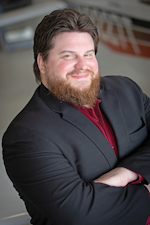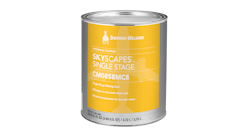As the COVID-19 pandemic shows some signs of receding, many around the world, inside and out of the aviation industry, are looking at how to build back to pre-pandemic levels of operation. But for those in the business of painting aircraft, they’re looking at how to keep pandemic numbers going.
Business has been booming during the downturn of the pandemic. Fewer planes in the sky have meant more time in the hangar getting new coats and more done, and the trend is predicted to keep going.
Randy Johnson, director of corporate aircraft services at King Aerospace, said they did experience a brief period of slow down during the first year of the pandemic, but it turned around quickly.
“We actually had a pretty good schedule built all the way through about August [2020]. We didn’t feel a whole lot of pain until maybe October. It gave us six months or so to sell September, October, November. We had a pretty slow September and pretty slow October in 2020. But I’ll tell you, since November of '20, we’ve done well. We hit our forecasted number last year. And 2022, we’re full. We have no slots left in our paint department,” Johnson said.
As this AMT article was being written, Johnson said King’s maintenance bays were roughly 80 percent taken for the year.
“So, we’ve persevered through it. We’ve heard a lot of horror stories, but we’ve been pretty blessed throughout this pandemic,” he added.
Jay Prideaux, paint manager, Ballard Aviation, adds that they too have experienced much of the same during these past pandemic years.
“There’s been challenges, but it’s been brisk. It’s been crazy, especially with the sales side of it. There are people buying airplanes now that would not have ever bought an airplane before this, I don’t believe. Which has made it challenging for us to find schedule to paint airplanes. So, it’s not what the rest of the world sees in being slow. We’re exactly the opposite, completely busy and struggling to find places to paint airplanes,” he said.
“You know what? Clientele has been a blessing. Having this pandemic for aircraft has been life changing, but for the good,” added Teresa Arredondo, president & CEO of ArtCraft Paint. “The customers, they keep coming. Their financials were probably better than before. That’s why they took the initiative, the time and the decision to paint … their aircraft during the pandemic because they were not flying that much.”
Arredondo added that demand has been so high, they have had to add more staff since the onset of the pandemic. Pre-pandemic, Arredondo said they had 19 people on staff; today, ArtCraft has 32.
And the demand doesn’t appear to be dwindling anytime soon. Johnson said King Aerospace is already booking slots for 2023, and his slots for Boeing Business Jet-size (BBJ) aircraft is full for ’23.
“I think my large aircraft bay is full. That’s for BBJ-size aircraft, which I think we can do maybe six of those a year. It’s already full for next year,” he said, adding he also is getting calls for corporate jets.
“Oh, I see it continuing,” Prideaux said of demand. “I don’t see anything slowing down. I really don’t. We’re still in that same game of trying to plug airplanes in, and calendar’s still the same, but we got more airplanes. We’re just struggling to get everything in and get it done.”
The Dual Edge of Success
With work on the uptick, the boom in business has revealed the greatest challenge paint shops are facing — employment and lack thereof.
“I think the pandemic drove our business up, which in turn made it better for everybody. They have different options and the pool is smaller. I don’t think there’s as many people getting into this business and that’s too bad. It’s a very rewarding career, but that has been the big challenge, is keeping people and then hiring new folks,” said Prideaux.
Johnson said having the staff they need is the one thing that has been holding them back in the wake of the increased demand.
“The negative downfalls we’ve seen since probably July, August of '20 is workforce demand. I mean, you just can’t find people. I don’t know where you point the finger at, but I do know there was a lot of additional unemployment paid out and financial subsidies to people. And then there was just a lot of people scared to get out and mix it up still. So, you put all that together with all of our aviation industry and our blue collar workforce, it left a strain on all of us to try and find enough people to service the industry,” Johnson said.
He said the issue has improved somewhat since those early days of the pandemic, but the outlook is still not great. King went from having 16 open slots to now having five, but has been trying to fill those for over six months.
The solution has been for shops to get creative with their hiring and training requirements. Arredondo said they began thinking entirely outside of the box.
“Early years of my career in aircraft painting, I hired people that they came from other companies. I found out that they were coming with bad habits. So, what I did is I started to create my own painters,” she said. “So now, the solution is, you don’t find good painters, you train them.”
Arredondo has made ArtCrafts’ culture into what she calls “a second opportunity company,” with an eye on employing veterans.
“Veterans are the people, they need a second chance,” she said. “If there’s a veteran that needs a job, they don’t go through an interview. They don’t go through nothing. We just say, ‘You want to come and be part of the family?’ And they say, ‘Yes.’ ‘Okay. I’ll see you tomorrow at 7:30.’ And right when they get here, we slowly fill out the paperwork and then we go into fun stuff. And then we do the training. Safety training, and then they go do hands on.”
Prideaux is taking a similar approach to hiring, having to pull from less experienced workers than he did previously.
“We’re trying to share our education, pass down our knowledge. Starting with younger guys and trying to bring them up. So that’s the thing, just trying to train guys that are willing to work, have a good work ethic, but they don’t really know anything so you’re having to step back and that’s going to slow you down just a little bit too,” said Prideaux.
Consistent Clientele, Consistent Equipment
While the increase in business and the decrease in employees may be new with the pandemic, some things stand the test of time. Namely, the equipment utilized for the work.
“You know, I’m kind of an old guy and I’m of the school, if it ain’t broke, don’t fix it, so we’re using water paint guns, HVLPs and the old trusty Binks 2-and-a-half-gallon pots, and we’re getting the job done,” said Prideaux. “We’ve tried a couple of the 3M guns, just for something different. All around, neat guns because you can change it up. But as far as equipment, that’s basically the only thing we’ve changed up was a couple of cup guns.”
If it isn’t broke, don’t fix it is Arredondo's mantra as well.
“This is the way I work. I replace what I need to replace when it’s needed. So, for example, a tool that is needed and used every single day: the spray gun. I don’t replace that spray gun unless it’s not efficient anymore,” she said, adding as long as the equipment they use isn’t putting them at a disadvantage, they have no need to spend the money on something new.
“I won’t replace it because there’s a new technology out there that is going to ‘blah, blah, blah,’ I always do an evaluation. How much is it going to cost, how long is it going to take, how much money am I going to make?” Arredondo continued.
Johnson too said they haven’t made any significant upgrades as of late.
“We have converted to electrostatic paint equipment about a year and a half ago. That was new to me, I’m old school guy. Our teammates, younger generation, they seem to like those. Hasn’t really had any negative effect on our quality. It’s pretty much across the board equal,” he explained.
And along with the little change in equipment, there has been little difference from what the clientele is asking for compared to non-pandemic years, with customers also taking a," if it works, why fix it," mentality.
“[It’s] pretty much the same. We’ve taken on a customer that operates air ambulance, and they are really into SootGuard Clear. It’s a clear that’s real easy to clean. So it goes on turboprops to take care of the soot, and so that’s one of the things that we’ve dabbled in a little bit this year and last,” said Prideaux.
Johnson said they get a lot of requests for stripping paint along with general inspections for aircraft, particularly the BBJs, and there has been no slow down in those requests.
“One portion of our business is we do a lot of government contracts as well. And those typically don’t slow down much during crisis situations,” added Johnson. “We’re thankful to have what little bit of that sector we do. It allows us to keep people, even if it gets slow, we can scale back. I mean, I run about 50% contractors and 50% direct on the paint side. Luckily enough, there’s enough government work that people try and send our way that it enables us to keep our core people.”
Post-Pandemic Needs
As they turn their eyes to a, hopefully, pandemic-free future, the major concern in the painting business is keeping up with the new demand.
“I’m pretty sure that the next year we are going to double what we’re doing. Because we pretty much double what we did in 2019 on 2021, even though we had the pandemic. But the pandemic is the one that helped us be where we are,” Arredondo said. “We have 32 people now. That means that we are going to have like 65 next year. That’s going to be more opportunities for more second-chance opportunity employees.”
“Coming out of the pandemic, we’re just hoping to continue to be proactive,” said Johnson. “We’re trying to keep stock of items that we don’t run out of. And I think any, not just a paint shop, but anyone that deals in stuff that materials is, you’re in the business. You just well stock up and try to stay ahead of it because we’re going to hit, we’ve already seen it. You’re going to hit lead time issues that you can’t deliver.”
And Prideaux said their priority is to just be able to do more aircraft.
“Possibly expand our footprint,” he continued, “and we’re just leaving a lot of money on the table. I hate telling people no. I love to say yes. So just being able to have a place to do the work. Unfortunately, you can’t always just throw heads at it, right, manpower, in our business, it, it doesn’t always help. So you’ve got to have the facility. So that’s one of our goals for the future.”






